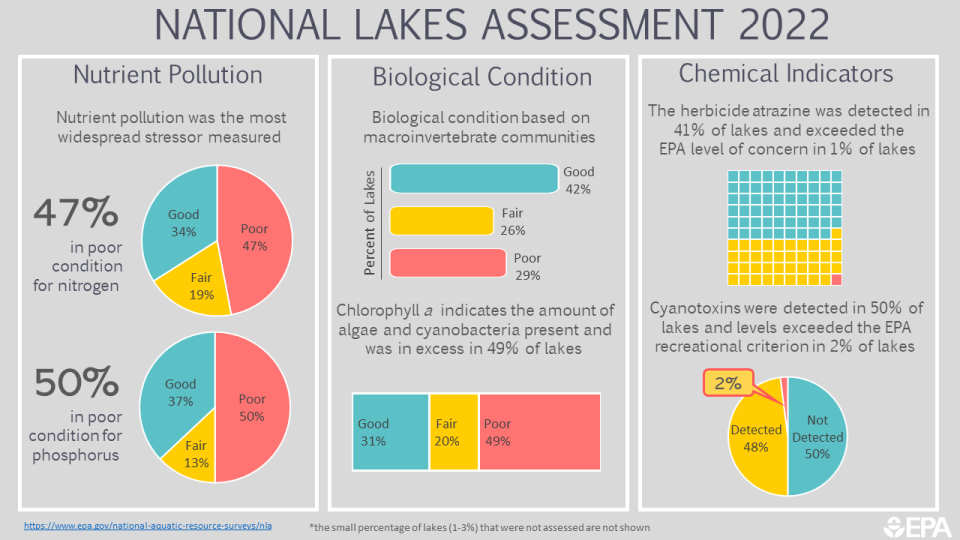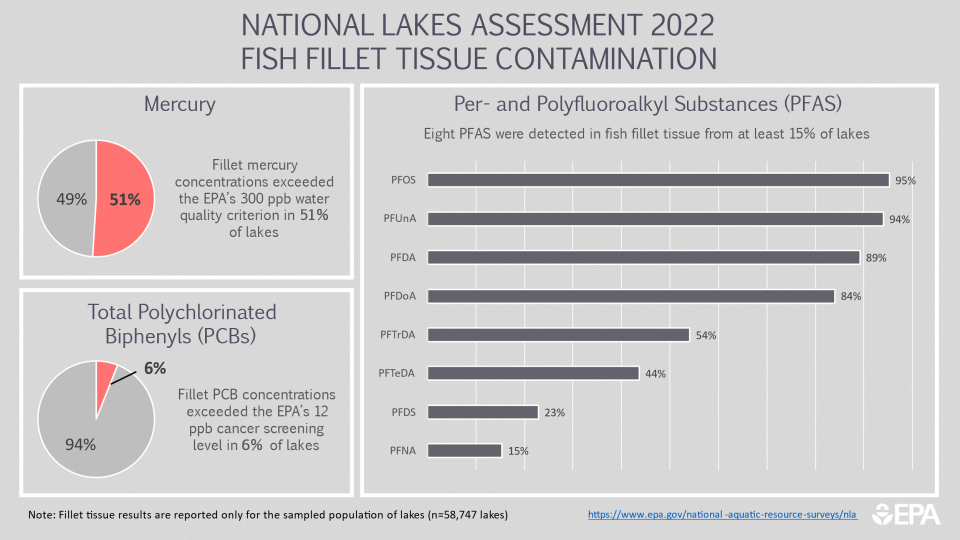National Lakes Assessment 2022 Key Findings
National Lakes Assessment: The Fourth Collaborative Survey of Lakes in the United States
Key Findings
Healthy lakes enhance our quality of life. They sustain food webs and provide habitat for fish and wildlife. Lakes contribute to a healthy economy, supporting tourism and recreation and supplying drinking water. For the National Lakes Assessment, EPA, states, tribes, and other partners surveyed a wide array of lakes, from small ponds and prairie potholes to large lakes and human-made reservoirs.
The National Lakes Assessment: The Fourth Collaborative Survey of Lakes in the United States presents the results of the 2022 survey of lake condition in the conterminous United States. The National Lakes Assessment is part of the National Aquatic Resource Surveys, a series of statistically-based assessments designed to provide the public and decision-makers with nationally consistent and representative information on the condition of the nation’s waters.
To read the complete report, visit the NLA 2022 web report site.
Nutrient pollution was the most widespread stressor measured.
- Across the country, 50% of lakes were in poor condition with elevated phosphorus, and 47% were in poor condition with elevated nitrogen.
- Excess nutrients can contribute to algal blooms and low oxygen levels, affecting ecological health, public health and recreation in lakes.
High levels of algae and cyanobacteria growth were observed.
- Hypereutrophic conditions, typically characterized by excess nutrients high levels of algae growth and low transparency, were observed in 30% of lakes.
- Chlorophyll a, which indicates the amount of algae and cyanobacteria present, was in excess and rated poor in 49% of lakes.
Poor biological condition was more likely when lakes were in poor condition with respect to nutrients.
- Nationally, in lakes where phosphorus was elevated, benthic macroinvertebrate communities (e.g., insect larvae, snails and clams living on the lake bottom) were 1.7 times more likely to be in poor condition. In natural lakes (i.e., excluding reservoirs), this risk increased to 2.2.
- Based on benthic macroinvertebrates, the EPA found that 29% of lakes were in poor condition and 26% of lakes were in fair condition.
- Based on zooplankton (microscopic animals in the water column), 25% of lakes were in poor condition and 25% of lakes were in fair condition.
Lakeshore disturbance was widespread, yet other physical habitat conditions were rated good in more than half of all lakes.
- Only 16% of lakes were in good condition based on lakeshore disturbance measures, indicating moderate to high levels of human activity and shoreline alterations in 84% of lakes.
- Drawdown was poor in 5% of lakes, representing 13,400 lakes. The drawdown indicator measures water levels and their fluctuation; large drawdown indicates poor habitat condition.
- Most lakes were rated good for shallow water habitat (55%), riparian (lakeshore) vegetation cover (52%), and habitat complexity (51%) conditions.
- Poor biological condition was twice as likely when riparian vegetation cover or lake habitat complexity were in poor condition.
Microcystins, a type of cyanobacterial toxin, were detected in 50% of lakes.
- Microcystins measured in the open waters exceeded the EPA recreational criterion in 2% of lakes, representing 5,360 lakes across the nation.
- Cylindrospermopsin, another cyanobacterial toxin, was detected in 12% of lakes but did not exceed the EPA recreational criterion in any lakes during the 2022 survey.
- For information on cyanotoxins in specific lakes, people should check with state, Tribal or local governments before swimming, boating or fishing.
The herbicide atrazine was detected at low levels in 41% of lakes.
- Atrazine levels exceeded the EPA benchmark, the "concentration equivalent level of concern" for aquatic plant communities, in 0.9% of lakes, representing 2,430 lakes.
Contaminants were present in all fish tissue, but risk varied by contaminant and by fish consumption level.
- Every fillet tissue sample contained detectable levels of mercury and polychlorinated biphenyls (PCBs), which corresponds to an estimated 58,747 lakes containing fish with detectable levels of these contaminants.
- In the lakes assessed for per- and polyfluoroalkyl substances (PFAS), an estimated 95% contained fish with detectable levels of perfluorooctane sulfonic acid (PFOS). In addition, seven other PFAS were detected in fish collected from at least 15% of lakes. Sixteen of 40 tested PFAS were not detected in any of the tissue samples.
- The percentage of lakes that contained fish exceeding mercury and PCB screening levels in fillet tissue is as follows:
- Mercury: 51% exceeded the EPA’s tissue-based water quality criterion for mercury.
- Total PCBs: 23% exceeded the cancer screening level for high-frequency fish consumers, who eat four or five 8-ounce meals per week, and 6% exceeded the cancer screening level for general fish consumers, who eat just one 8-ounce meal per week.
- People who eat locally caught freshwater fish should consult state and Tribal agencies responsible for issuing fish advisories.
Key Findings on Change from 2017 to 2022
For both nutrients and biological indicators, there was little change between surveys at the national level.
For both microcystins and atrazine, the small percentage of lakes with concentrations that exceeded the human health (2%) and aquatic life (0.9%) risk benchmarks, respectively, did not change significantly.
There were significant changes in some chemical and physical habitat measures in 2022.
- The number of lakes with good shallow water habitat decreased by 9 percentage points, to 55%.
- The number of lakes with good ratings for lakeshore disturbance decreased by 9 percentage points, to 16%.
- Detection of microcystins increased by almost 30 percentage points, to 50%.
- Detections of atrazine increased by 11 percentage points, to 41%.


